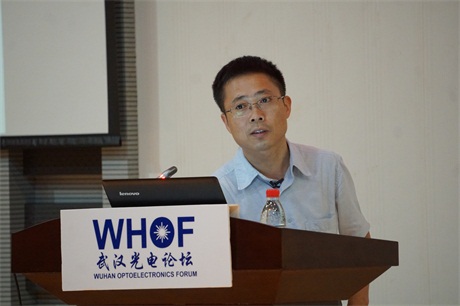WUHAN, China (May 31, 2018) - Wuhan Optoelectronics Forum No. 140 was successfully held in Auditorium A101 at Wuhan National Laboratory for Optoelectronics (WNLO) in the morning of May 31. Prof. Limin Tong from Zhejiang University delivered an exciting talk entitled Optical Microfibers and Nanofibers: Recent Progress and Future Opportunities. Prof. Jian Wang, from WNLO chaired the forum. Prof. Xinliang Zhang, Deputy Director of WNLO, awarded Prof. Limin Tong the forum medal.
Manipulating light on a lower dimension is always of intense interest to both fundamental research and technological applications. Among various nanostructures for low-dimensional photonics, the one-dimensional microfiber or nanofiber (MNF) is of great importance owing to its capability of routing tightly confined light fields in single-mode with least space and material requirement, minimized optical path, and high mechanical flexibility. Free-standing optical MNFs fabricated by physical drawing techniques surpass micro/nanowaveguides fabricated by almost all other means in terms of sidewall smoothness and diameter uniformity, conveying their low waveguiding losses. With high index contrast between the core and the surrounding, an MNF can guide light with tight optical confinement and/or high fractional evanescent fields. For example, by increasing wavelength-to-diameter ratio of a nanowire, the fractional power of the evanescent fields in the guiding modes can be enlarged to over 80% while maintaining a small effective mode area, which may enable highly localized near-field interaction between the guided fields and the surrounding media. This talk will summarize our recent progress in optical MNFs from fabrication, functionalization to application, with emphases on MNF sensing, optical modulation and on-chip integration. Similar one-dimensional photonic structures such as semiconductor nanowires (also called “nanofiber” in recent literatures) will also be mentioned. Finally, challenges and future opportunities in this field will be briefly discussed.
Limin Tong received his BSc degree (1991) and MSc degree (1994) in Physics, and PhD degree (1997) in Materials Science and Engineering, all from Zhejiang University, China. In 1997 he joined Department of Physics at Zhejiang University as an assistant professor. From 2001 to 2004, he joined Mazur Group at Harvard University as a visiting scientist, and returned Zhejiang University in 2004, where he established a Nanophotonics Group (www.nanophotonics.zju.edu.cn). He is currently a professor of the College of Optical Science and Engineering at Zhejiang University. His research interests are in nanophotonics and fiber optics, with emphases on nanofiber/nanowire photonics, nanoplasmonics and devices. He received the Chang Jiang Scholars (Ministry of Education, China) in 2012, the WANG Daheng Optics Prize (Chinese Optics Society) in 2007, and the National Science Foundation for Outstanding Young Talents (NSFC) in 2004, respectively. He is a fellow of the Optical Society of America, an Associate Editor of Optica, and has been serving as Advisory Board Member for Optics Communications, Editorial Board Member for Chinese Optics Letters, Photonic Sensors, Chinese Physics B and Sensors.

